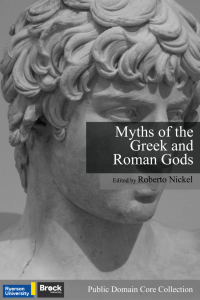Case Studies from the Public Domain
Greek and Roman Myths Case Study
Book used: Myths of the Greek and Roman Gods
Dr. Roberto Nickel replaced his final exam with a Hypothes.is web annotation in his 500-person first-year Greek and Roman Myths course. The goal was to facilitate student engagement with the text and, by its collaborative nature, make students aware of differing perspectives that will break down the idea of one monolithic, “correct,” professor-led interpretation. By having students access their peers’ annotations, they were able to see differing perspectives that expand their own views of a text. Hypothes.is facilitated a more focused approach to close reading by allowing students to prepare and to share their annotations ahead of any synchronous meetings.
In the first year, the instructional team developed a rubric to allow first-year students to complete an initial annotation of a text. The rubric is described as the QuICKeR framework (Question, Interest, Knowledge, Response).
- Students will ask a question that stimulates discussion,
- Share something of interest (either personal or scholarly) within the text,
- Make a connection between one passage and another (in the same or another text read in the course),
- Share a piece of knowledge that will help a first-time reader better understand the text, and finally,
- Respond to someone else’s question or expand on someone’s connection or point of interest.
Students were asked to tag each of their questions as “question,” points of interest as “interest,” and so on to facilitate tracking and grading for teaching assistants.
In addition to applying the QuICKeR framework, students also tracked certain mythological figures, story patterns, and phenomena that appear in multiple texts through the use of appropriate tags. In each of the ten lessons, students annotated a primary text which served as the main focus of that lesson. In addition to this principal text, students were assigned a companion self-study text to annotate. For example, the main focus of Lesson 5 was the Homeric Hymn to Demeter; in addition to annotating this text using the materials provided in the lesson, students annotated Ovid’s version of the rape of Proserpina in book five of the Metamorphoses as a self-study exercise.
Finally, students were required to use and cite their own and their group’s annotations as sources for short reflection essays and a final longer essay. The aim in doing so was to encourage and foster ongoing engagement in the course readings throughout the semester.
Feedback from students indicated that while using Hypothes.is helped facilitate their learning, the requirement to annotate both a guided reading and a self-study reading was too large of a workload. This manifested in the quality of some of the work; some of the annotations read as if students were checking boxes of compliance rather than engaging in text.
As such, in its subsequent offerings of CLAS1P95, the number of annotation assignments was modified significantly. Instead of ten annotations a week, the requirement was reduced to three. The QuICKeR rubric became ICR—Interest, Response, Connection. As a result, the complexity and depth of the annotations greatly improved.
In an online environment, this exercise builds community and facilitates synchronous meetings between students and their teaching assistants each week. At a more philosophical level Hypothes.is developed students’ understanding of how to do their own close readings and ultimately broadened their perspectives beyond the “all-knowing” professor.
The primary source readings for Greek Myths were put into an open PressBook as part of the Public Domain Core Collection so that future courses could easily integrate web annotation into their courses.


